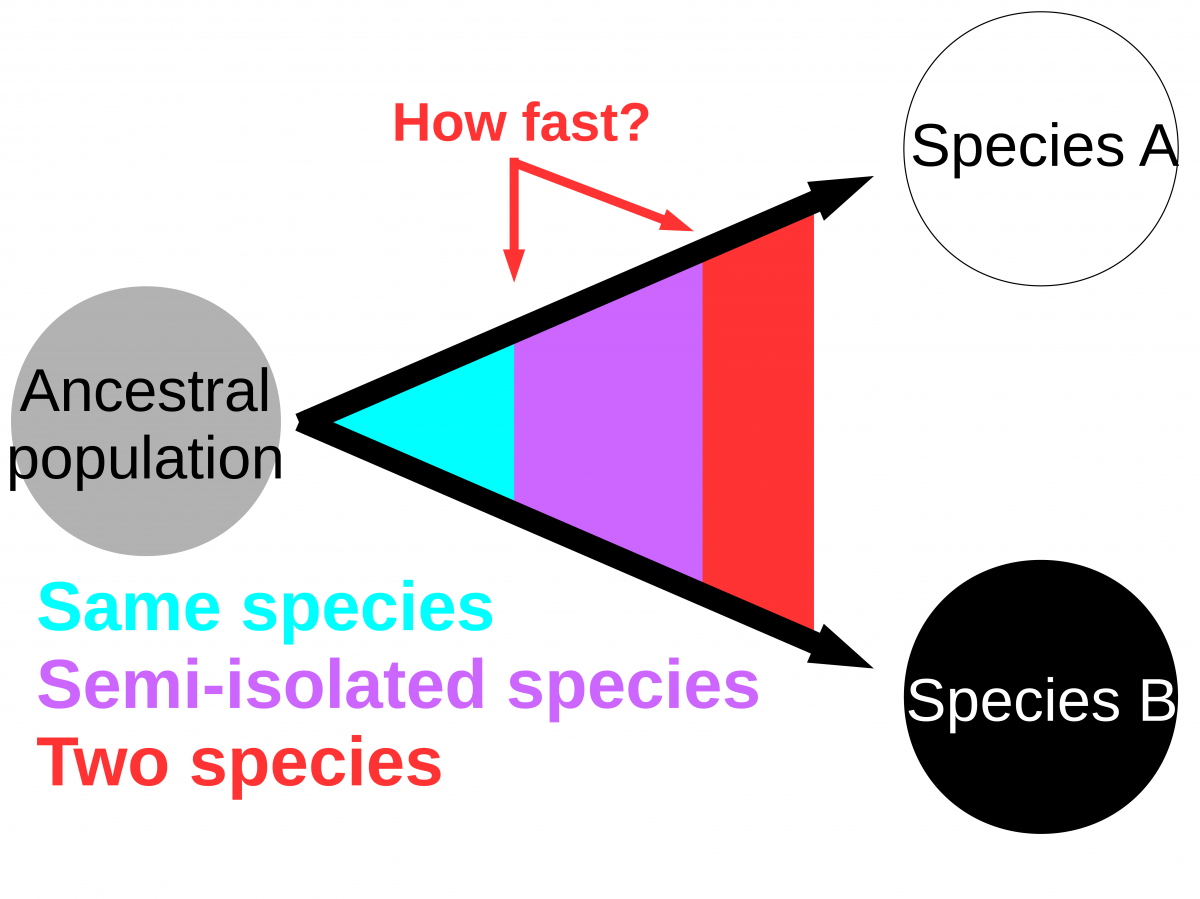Speciation
Members
Researchers
Technical staff
Post-docs
Phd
Masters
Objectives
Diversity, measured by the number of currently existing species, is the result of a dynamic that combines processes generating new species (speciation events) and others that dwindle the number of taxa (extinctions). Contemporary extinction rates, as measured by the reduction in the number of species or by the ongoing reduction in population sizes, are found to be extremely high in both plants and animals, presumably as a consequence of ongoing global changes. Although the diversity of factors responsible for extinctions are beginning to be well understood, our knowledge on the mechanisms of speciation is less consolidated. Developing a detailed insight into the speciation process will require us to understand the various factors that cause reproductive isolation, i.e. the evolution of the so-called species barriers. Of particular importance are the specific barriers occurring at the origin of the reproductive isolation between diverging lineages, as their effects on hybrid viability or hybrid fertility determine the possibility of hybridization between diversifying lineages. We aim to study this process at various levels. First at the genomic level, by identifying some genomic factors explaining the local density in speciation genes. Some of the large chromosomal patterns are already well-identified: for instance, sex chromosomes strongly concentrate genes acting as barriers between species. Second, at the geographical level as isolation of populations will tend to facilitate the fixation of these species barriers, whereas migration may slow down differentiation and reverse incomplete species barriers. Secondary contact between two formerly isolated lineages with semi-permeable barriers may also increase the strength of isolation in hybrid zones by the reinforcement of reproductive isolation. Third, at the environmental level, as adaptive walks of populations in similar or different niches are expected to lead to the accumulation of mutations of different effects on the hybrid fitness. The main objectives of this new speciation group are to explore the contributions of genomic, geographic and environmental factors on the emergence of new species. To answer these questions on different evolutionary time scales, the group gathers researchers in paleontology, genetics, genomics, bioinformatics, phylogeny and quantitative morphology.

Ongoing projects.
Use of allelic and phylogenetic diversity at the self-incompatibility locus of Brassicaceae as a marker of bottlenecks associated with speciation. C. Poux, C Roux and X. Vekemans (PI).
In this project we compare allelic diversity and phylogenetic relationships among alleles at the self-incompatibility locus within and between related species in order to identify possible bottlenecks associated with speciation events. This approach, using the phenomenon of increased conservation of ancestral polymorphism under the effect of strong balancing selection at the self-incompatibility locus (cf. Castric et al. Plos Genetics, 2008) is complementary and will be compared to the historical demographic inference approach based on neutral polymorphism at the genome level.
Development of demographic inference methods taking into account selection. C. Mazoyer, X. Vekemans and C. Roux (PI)
We are developing a web application to produce demographic inferences from sequencing data in order to 1) study changes in population size over time; 2) test different introgression patterns; 3) detect barriers to gene flow, by taking into account genomic variations in effective population size due to genetic interference, as well as genomic variations in introgression rates caused by semi-permeable barriers.
Linking microevolutionary and macroevolutionary processes of diversification in evolutionary radiations of freshwater mollusks from the East African Rift. C. Blassiau, C. Calarnou, M. Genete, C. Gode, C. Ortiz, C. Roux, X. Vekemans and B. Van Bocxlaer (PI)
Work in evolution, ecology and paleontology has resulted in a great body of knowledge on processes contributing to reproductive isolation between extant populations and on how organismal diversity has waxed and waned through time. How mechanisms that cause differentiation among populations ultimately contribute to macroevolution remains currently unanswered, however. We address this and related questions with phylogenetic/genomic and population genetic/genomic approaches at various spatial and taxonomic scales of organization in freshwater mollusks form the East African Rift. Much of our focus is on small evolutionary radiations, which are the building blocks of African freshwater mollusk diversity. Our studies often include examinations of morphological disparity, including of the fossil record, and laboratory experiments designed to test hypotheses constructed from molecular and morphological studies, such as whether certain traits are inherited and adaptive. Finally, we are also interested in community assembly, the environmental context of parasite transmission by freshwater mollusks and conservation biology.
Speciation and mating systems in Silene. F. Carpentier, S. Gallina, C. Godé, Z. Postel, C. Poux, C. Roux, E. Schmitt, X. Vekemans and P. Touzet (PI)
We are studying the interplay of mating systems and the emergence of reproductive barriers in two mating systems:
– gynodioecy, i.e. the co-occurrence in populations of females and hermaphrodites, that can favor the maintenance of old and divergent cytoplasms through balancing selection. We hypothesize that such system might allow the accumulation of cytonuclear incompatibilities among geographically isolated lineages. We test this hypothesis on Silene nutans, a gynodioecious species that revealed to be a species complex, with at least 4 different genetic lineages. Inter-lineage hybrids exhibit strong postzygotic reproductive isolation mostly due to cytonuclear genetic incompatibilities. This project (Zoé Postel’s PhD thesis) aims to identify co-evolved cytonuclear gene pairs that have been disrupted in these hybrids, and propose an evo-demographic scenario on this speciation process through ABC approaches. This project relies on a long and strong collaboration with Fabienne Van Rossum from Meise Botanic garden, Belgium.
– dioecy, i.e. the co-occurrence in populations of females and males. When dioecy is determined by sex chromosomes, we hypothesize that sex chromosomes might accumulate genetic incompatibilities, that leads to the Haldane rule: the heterogametic sex is more affected in interspecies hybrids. We want to test this hypothesis on the dioecious species in the Silene section Otites.
Collaborators on Silene nutans: Jean-Stéphane Varré (CRIStAL, Univ. Lille), Fabienne Van Rossum (Meise Botanic Garden, Belgium)
Collaborators on the section Otites: Gabriel Marais (LBBE, Univ. Lyon), Bohous Janousek (Institute of Biophysics, ASCR, Brno, Czech Republic)

